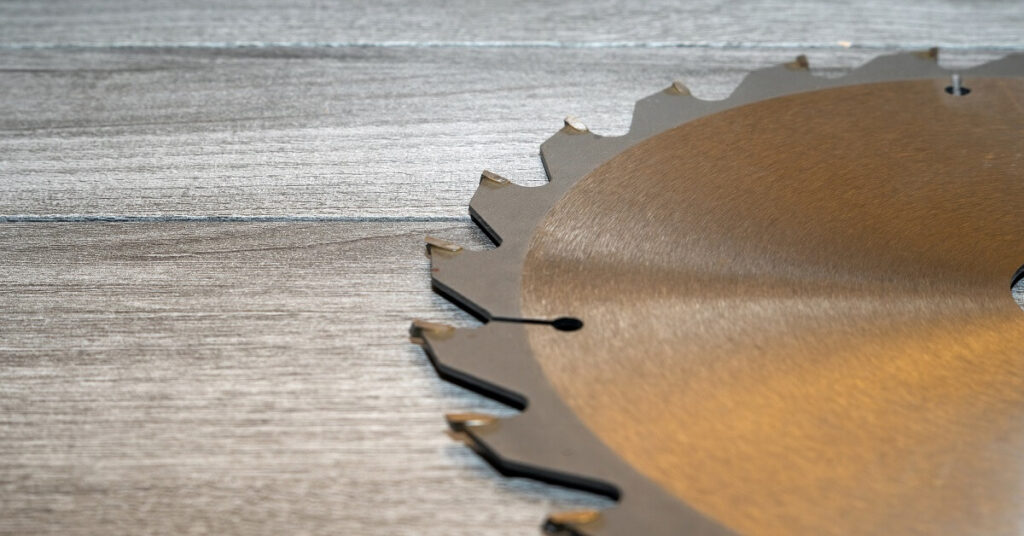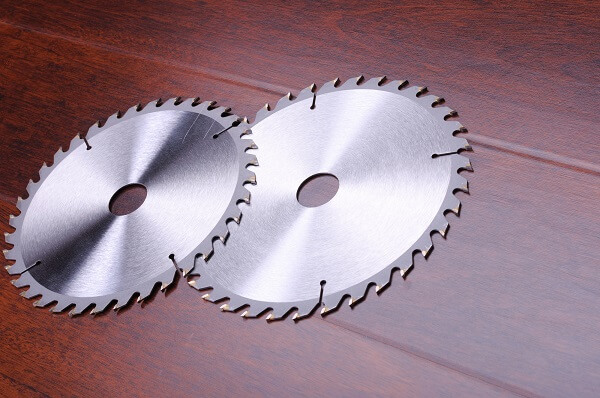How To Sharpen A Circular Saw Blade By Hand?

Sharpening a circular saw blade by hand entails removing tiny quantities of material to restore the blade’s edge. It is a low-cost and practical option that DIYers or professionals may use to sharpen their blades on the job site or in the workshop.
What is the Importance of Sharpening Saw Blades?
Sharp saw blades make cleaner, more precise cuts and prolong the blade’s life. Dull blades may result in poor cut quality and can force the saw to work harder, perhaps causing damage to the motor and other saw components. Sharpening the blade prevents mishaps since a dull blade might bind or deflect when cutting.
Equipment and Materials Needed for Sharpening
- A round file
- A flat file
- A file guide (optional)
- Safety glasses
- Gloves
Safety Precautions Necessary
- Always protect yourself from flying debris and the sharp edges of the saw blade by using safety glasses and gloves.
- While filing, secure the saw blade in a vice or clamp to prevent it from moving.
- Ensure that the saw blade is stopped prior to sharpening it.
- Follow the saw blade and file manufacturer’s directions to verify that you are using the proper technique and instruments.
- Be cautious not to remove an excessive amount of material, since this might weaken the blade and diminish its efficacy.
How do you Prepare the Saw Blade for Sharpening?

The skill of manually sharpening a circular saw blade starts with removing the blade from the saw and ensuring that the saw is disconnected and turned off. Important tasks include cleaning the blade using a brush or cloth, checking it for indications of wear and damage, and measuring the tooth angle with a protractor or angle finder. Using a wrench or pliers to release the bolts or nuts and a specialised triangle file or saw set to sharpen the teeth to the proper angle, you may give your saw blade fresh life. However, if the blade is irreparable and exhibits serious symptoms of the damage, it may need to be changed to maintain the safety and effectiveness of its usage.
Removing the Blade from the Saw
To manually sharpen a circular saw blade, it must first be removed from the saw. Ensure that the saw is switched off and disconnected from the power source before proceeding. Then, you must release the bolt or nuts that hold the blade in place. Loosen the bolts or nuts using a wrench or pliers, and then carefully remove the blade from the saw.
Cleaning the Blade
After removing the blade, it is essential to clean the teeth to eliminate any dirt, sawdust, or other material that may have been collected. Use a brush or towel to clean and then dry the blade.
Examining the Blade for Wear and Damage
After cleaning the blade, examine it for indications of damage or wear. Examine the teeth for any nicks, chips, or fractures. Depending on the severity of the blade’s damage, it may need to be replaced.
Measuring the Blade’s Tooth Angle
To sharpen the teeth of a circular saw blade, the angle of the teeth must be measured. To measure the angle of the teeth, you may use a protractor or angle finder, or a gauge or template created for this purpose. Once the angle of the teeth has been calculated, a file or saw set may be used to sharpen the teeth to the right angle.
Note: There is a nice app called Diskometer that can help you to do this task. Although, it is a paid app.
Sharpening the Teeth of the Saw Blade
With the assistance of a triangle file, you can precisely sharpen each tooth of the circular saw blade to improve its edge. Maintaining the appropriate angle when filing each alternate tooth in a rhythmic rotation requires attention and dedication. After each session of filing, you must evaluate the blade’s sharpness and, with patience and perseverance, continue the procedure until a faultless, razor-sharp edge is attained.
Filing the Teeth with a Triangular File
After determining the angle of the teeth, you may sharpen them using a triangle file. A triangle file is a triangular-shaped tool meant for honing saw teeth. Position the file at the angle of the tooth, and then fill the tooth using a forward and backward motion.
Maintaining the Correct Tooth Angle While Filing
It is essential to maintain the right tooth angle during filing. If the tooth is filed at the wrong angle, it will not cut effectively and the blade will be less effective. When filing the teeth, be careful to hold the file at the right angle and maintain its level.
Filing Every Other Tooth in a Rotating Pattern
It is vital to file every other tooth in a rotating pattern while preparing the teeth for fillings. This ensures the teeth are uniformly spaced and helps preserve the blade’s balance. Beginning with one tooth, go to the next tooth in a circular sequence.
Checking the Sharpness of the Teeth After Filing
After the teeth have been filed, it is essential to examine their sharpness. You may examine the sharpness of the teeth with a file or saw set. If the teeth are not sufficiently sharp, they may be filed until they are. Repeat the sharpening procedure until you are pleased with the results.
Finishing the Sharpening Process
You must examine the blade for any indications of wear or damage, reattach it to the saw with care, thoroughly verify its sharpness and accuracy, and then clean and store it in a dry, secure location. If the blade has been irreversibly broken, it must be replaced immediately. And after the blade has been reinstalled, you should do a test cut to guarantee maximum sharpness and accuracy. If the blade is still too short, the procedure of filing must be repeated. With proper maintenance, however, the blade will be preserved in perfect shape, prolonging its life and ensuring that it is always available for use.
Inspecting the Blade for any Damage or Wear
After you have completed filing the teeth, re-examine the blade for indications of damage or wear. Examine the teeth for any nicks, chips, or fractures. Depending on the severity of the blade’s damage, it may need to be replaced.
Reinstalling the Blade on the Saw
Once the blade has been examined, it may be reinstalled on the saw. Align the blade with the arbor of the saw, and then tighten the bolts or nuts that hold the blade in place.
Testing the Blade for Sharpness and Accuracy
After replacing the blade, evaluate it’s precision and sharpness. Test the saw by making a test cut through a scrap of wood. Examine the cut for indications of unevenness or roughness. If the blade is not sharp or precise enough, continue the procedure of filing until the desired results are achieved. Maintenance and Storage of the Saw Blade: After testing the blade, thoroughly clean and preserve it. Wipe the blade clean before storing it in a dry location. This will assist to extend the blade’s life and guarantee that it is always ready for use.
Saw Blades: Tips for Maintenance and Care
How to Increase the Durability of Saw Blades:
- Utilize the appropriate blade for the task to prevent overloading or straining the blade.
- Avoid cutting nails, screws, and other metallic things that might harm or dull the blade.
- Regularly remove any dirt, dust, or sap accumulation from the blade.
- Keep the blade in a dry location and shield it from moisture, rust, and corrosion.
Cleaning and Storage Tips for Saw Blades
- After each usage, wipe the blade clean with a clean cloth or brush.
- Use a spray or lubricant containing silicone to prevent the blade from rust and corrosion.
- Keep the blade in a cool, dry location, away from direct sunlight and moisture.
A Safer, Easier Way to Clean Saw Blades by WoodworkersJournal – Watch this video.
Regular Inspections for Wear and Damage
- Examine the blade often for indications of wear, damage, or dullness.
- Examine the blade for any chips, fractures, or bowed teeth that might compromise its function.
- Examine the blade for any indications of overheating, such as discoloration or bluing.
When to Replace Saw Blades
- When the blade gets severely dull or damaged, it must be replaced.
- Replace the blade if it vibrates excessively or emits strange sounds.
- Replace the blade if it produces rough or uneven cuts or if it causes the saw motor to work too hard.
- If the blade has been damaged by cutting nails, screws, or other metallic things, it must be replaced.
Wrapping Up
Hand-sharpening saw blades entails removing the blade from the saw, cleaning it, examining it for damage or wear, measuring the angle of the teeth, and sharpening the teeth to the right angle using a triangle file. After each round of filing, the sharpness of the teeth should be examined to ensure that the process is proceeding correctly. Repeat the procedure until the teeth are razor-sharp and neatly cut.
More information to know. keep reading…
Importance of Regularly Sharpening Saw Blades
Sharpening saw blades is essential since it increases the blade’s life and preserves its efficacy. The teeth of a saw blade may dull or get worn over time, limiting its capacity to cut cleanly and effectively. By sharpening the blade on a regular basis, you can guarantee that it is always ready for use and performing at its peak.
Encouragement to Try Sharpening Saw Blades at Home
Saw blade sharpening is a simple and inexpensive activity that may be performed at home. Anyone can learn to manually sharpen saw blades with the proper equipment and a little bit of experience. Why not try sharpening them yourself if you’re wanting to prolong the life of your saw blades and save money on replacements?
Final Thoughts and Recommendations
In conclusion, hand-sharpening saw blades are a simple, effective, and inexpensive method for maintaining the performance of saws. Regular sharpening prolongs the blade’s useful life and ensures that it is always ready for use. By following the procedures given in the preceding section, you may learn how to sharpen saw blades at home, save money on replacements, and guarantee that your saws always cut cleanly and effectively.
